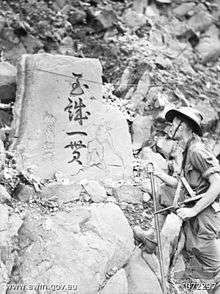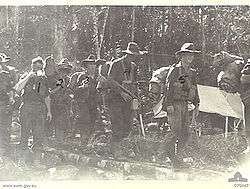57th/60th Battalion (Australia)
| 57th/60th Battalion | |
|---|---|
|
Men from the 57th/60th Battalion advance up the Faria River in February 1944 | |
| Active | 1930–46 |
| Country |
|
| Branch | Australian Army |
| Type | Infantry |
| Size | ~800–900 men[Note 1] |
| Part of | 15th Brigade, 3rd Division |
| Nickname(s) | Merri/Heidelberg Regiment |
| Colours | Black alongside Red |
| Engagements | |
| Insignia | |
| Unit Colour Patch |
|
The 57th/60th Battalion was an infantry battalion of the Australian Army which served during the Second World War. It was formed in 1930 as part of the Militia by the amalgamation of the 57th and 60th Battalions and was assigned to the 15th Brigade, 3rd Division in Victoria. Following the outbreak of the war, the battalion was initially used in a garrison role in Australia before being deployed to New Guinea in 1943, remaining there for almost 18 months before being brought back to Australia. Later, in mid April 1945 the battalion embarked for Bougainville where they took part in the advance towards Buin in the southern sector of the island. Following the end of hostilities the battalion was disbanded in March 1946.
History
The battalion was formed in 1930 by the amalgamation of two previously existing units of the Militia, the 57th and 60th Battalions.[2][3] The economic privations of the Great Depression and the end of the compulsory training scheme had resulted in a reduction in the size of Australia's military forces and as a result there was a need to rationalise the number of active units.[4] Upon amalgamation the battalion adopted the territorial title of the "Merri/Heidelberg Regiment" and they were assigned to the 15th Brigade, 3rd Division.[5][6]
At the outset of the Second World War, due to the provisions of the Defence Act (1903) which prohibited sending the Militia to fight outside of Australian territory,[7][Note 2][Note 3] the decision was made to raise an all volunteer force to serve overseas—initial operations were conceived to be likely in the Middle East, France and later possibly the United Kingdom—while it was decided that the Militia would be used to defend the Australian mainland and to improve Australia's overall level of readiness through the reinstitution of compulsory military service and extended periods of continuous periods of training.[9]
As a result, the battalion conducted a number of training camps during 1940 and into 1941 at Mount Martha before moving to Seymour in early 1942.[5] With the entry of Japan into the war and the potential threat that this posed to the Australian mainland the Militia were called up for full-time service to undertake defensive duties on the mainland and in the Australian territory of New Guinea. A few months later in March the battalion, along with the rest of the 15th Brigade was relocated to New South Wales where they were given the task of defending the Tweed Valley in case of Japanese invasion.[5] Late in the year the 15th Brigade was released from this task and sent north to Caboolture, Queensland, where they began training for deployment to New Guinea.[5]

The 57th/60th Battalion arrived in Port Moresby in March 1943. After this, while the rest of the brigade took part in the fighting around Lae and Salamaua, the battalion undertook defensive duties around the American airbase at Tsilli Tsilli.[5][10] Following the successful completion of the Salamaua–Lae campaign in September 1943 the battalion moved back to Port Moresby where it remained until early in 1944 when the 15th Brigade was detached from the 3rd Division and placed under the command of the 7th Division for its campaign in the Markham and Ramu valleys, arriving at Dumpu on 7 January.[10] In February, after fighting around the Kankiryo Saddle, the 15th Brigade moved up the Faria Valley to take over from the 18th Brigade and the 57th/60th Battalion relieved the 2/9th Battalion on the western side of the saddle.[11] The brigade then proceeded to advance towards Madang. Moving along the Bogadjim road, the battalion mounted a company attack on a Japanese position on the high ground overlooking Bogadjim near Bau-ak on 10 April; three days later they occupied the village.[12] After this, the 57th/60th continued the advance towards the coast and on 24 April 1944, a patrol from the battalion was the first Allied unit to reach Madang.[5]
In August, after almost 18 months abroad, the battalion was withdrawn back to Australia for rest and reorganisation on the Atherton Tablelands in Queensland.[5] At this time the battalion had an authorised strength of 803 personnel[1] and was organised into five companies: one headquarters company and four rifle companies (designated 'A' to 'D'). Headquarters company consisted of six platoons, numbered 1 to 6, fulfilling different support functions including signals, mortar, medium machine-gun fire support, anti-tank, pioneer and transport. Each of the rifle companies consisted of three platoons, numbered consecutively throughout the battalion from 7 Platoon to 18 Platoon.[13] Their stay in Australia proved short for the 15th Brigade as in April 1945 they received orders to rejoin the 3rd Division which was at the time on Bougainville as part of the II Corps;[5] the Australians having taken over responsibility for the island from the Americans in November 1944.[14] Following fighting around Slater's Knoll the 15th Brigade moved forward and relieved the 7th Brigade in the southern sector of the island and shortly afterwards resumed the advance along the axis of the Buin Road, crossing the Hongorai, Hari and Mobiai rivers before being relieved on 1 July by the 29th Brigade.[15] During this time the 57th/60th took part in the Battle of the Hongorai River, as well as the advance to the Mivo, undertaking a diversionary drive along the Commando Road on the left flank of the brigade's main effort.[5]
Following the brigade's relief in July, the battalion did not see combat again before the war came to an end. After this the demobilisation process began and the battalion's numbers slowly decreased. In December 1945, the battalion returned to Australia, arriving in Brisbane and moving to Chermside where on 30 March 1946 the battalion was disbanded.[5] During the battalion's active service in New Guinea and Bougainville it lost 58 men killed in action or died of other causes,[2][16] and 134 men wounded.[5] Members of the battalion received the following decorations: one DSO, eight MCs, one DCM, 14 MMs, 24 MIDs and two EDs.[5][Note 4]
Battle honours
For their service during the Second World War, the 57th/60th Battalion received the following battle honours:
- South-West Pacific 1943–45, Liberation of Australian New Guinea, Bogadjim, Mobiai River, Commando Road, Finisterres, Hongorai River, Hari River, Ogorata River, Mivo Ford.[2][5]
Notes
- Footnotes
- ↑ At the start of the war, the normal size of an Australian infantry battalion was 910 men all ranks, however, following the reorganisation of the 3rd Division along the jungle establishment, the size dropped to 803 men all ranks.[1]
- ↑ This stipulation also applied to the 2,800 strong Permanent Military Force.[7]
- ↑ Of the 32 Militia battalions that saw active service during the war, all but three were given AIF status. Essentially this meant that as more than 65 per cent of their wartime establishment had volunteered for service overseas, the battalion could be sent anywhere, including outside of Australian territory. The 57th/60th Battalion was one of the 29 battalions to receive this status.[8]
- ↑ This list differs slightly from that provided by the battalion historian, who lists one DSO, eight MCs, one DCM, 14 MMs, 24 MIDs and one ED.[17]
- Citations
- 1 2 Palazzo (2003), p. 6.
- 1 2 3 Box (1995), p. 35.
- ↑ Corfield (1991), p. 13.
- ↑ Palazzo (2001), p. 110.
- 1 2 3 4 5 6 7 8 9 10 11 12 13 "57th/60th Battalion". Australian War Memorial. Retrieved 26 December 2009.
- ↑ Palazzo (2002), p. 69.
- 1 2 Johnston (2007), p. 5.
- ↑ Johnston (2007), p. 9.
- ↑ Grey (2008), pp. 145–147.
- 1 2 Bradley (2004), p. 184.
- ↑ Bradley (2004), p. 241.
- ↑ Maitland (1999), p. 96.
- ↑ Corfield (1991), p. 329.
- ↑ Long (1963), pp. 92–94.
- ↑ Maitland (1999), pp. 123–124.
- ↑ Corfield (1991), p. 5.
- ↑ Corfield (1991), p. 340.
References
- Box, Allan (1995). Victoria's Diggers: A History of Each Victorian Military Unit Which Has Served Overseas From 1860 to 1945. Leongatha, Victoria: Box Military Books. ISBN 0-646-23519-2.
- Bradley, Phillip (2004). On Shaggy Ridge—The Australian Seventh Division in the Ramu Valley: From Kaiapit to the Finisterres. South Melbourne: Oxford University Press. ISBN 0-19-555100-1.
- Corfield, Robin (1991). Hold Hard, Cobbers: The Story of the 57th and 60th and 57/60th Australian Army Infantry Battalions, 1912–1990. Volume II (1930–1990). Glenhuntly, Victoria: 57/60th Battalion (AIF) Association. ISBN 0-646-04099-5.
- Grey, Jeffrey (2008). A Military History of Australia (3rd ed.). Melbourne: Cambridge University Press. ISBN 978-0-521-69791-0.
- Johnston, Mark (2007). The Australian Army in World War II. Botley, Oxford: Osprey Publishing. ISBN 978-1-84603-123-6.
- Long, Gavin (1963). The Final Campaigns. Australia in the War of 1939–1945, Series 1—Army. Volume VII (1st ed.). Canberra: Australian War Memorial. OCLC 1297619.
- Maitland, Gordon (1999). The Second World War and its Australian Army Battle Honours. East Roseville, New South Wales: Kangaroo Press. ISBN 0-86417-975-8.
- Palazzo, Albert (2001). The Australian Army: A History of its Organisation 1901–2001. Melbourne: Oxford University Press. ISBN 0-19-551506-4.
- Palazzo, Albert (2002). Defenders of Australia: The 3rd Australian Division 1916–1991. Loftus, New South Wales: Australian Military Historical Publications. ISBN 1-876439-03-3.
- Palazzo, Albert (2003). "Organising for Jungle Warfare". In Dennis, Peter; Grey, Jeffrey. The Foundations of Victory: The Pacific War 1943–1944 (PDF). Canberra, Australian Capital Territory: Army History Unit. ISBN 978-0-646-43590-9.
